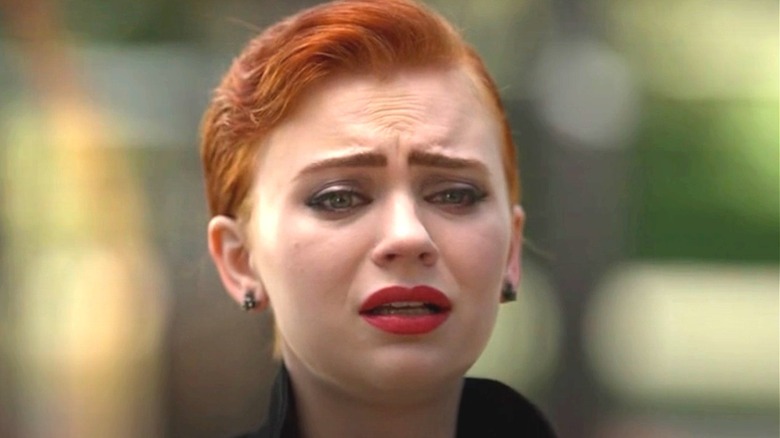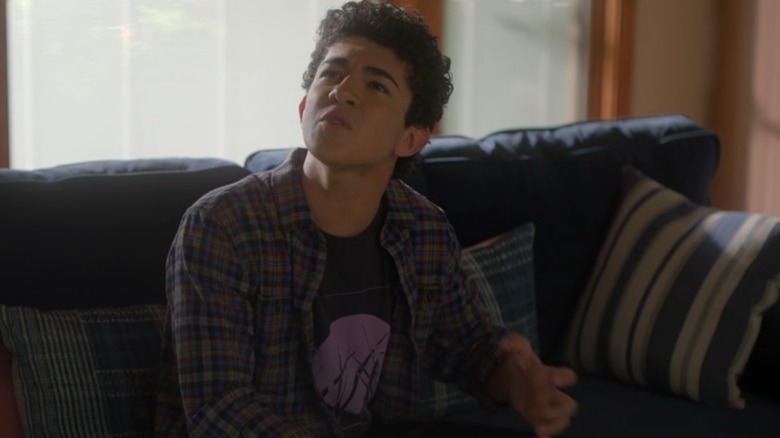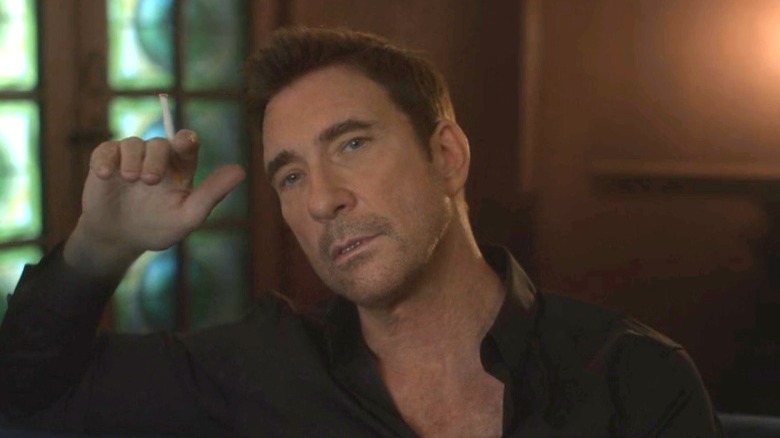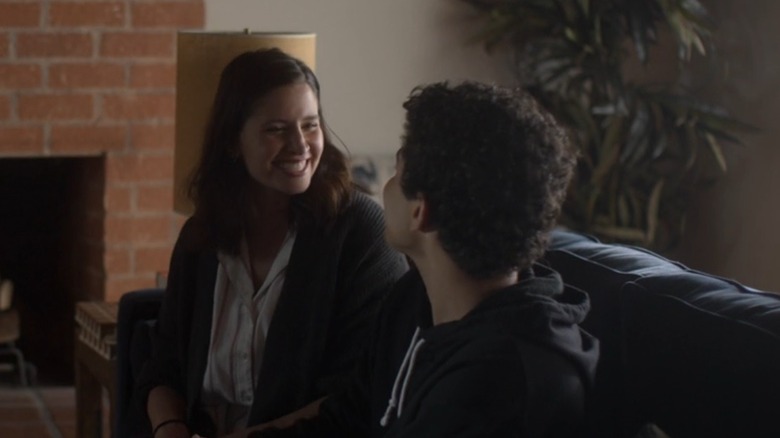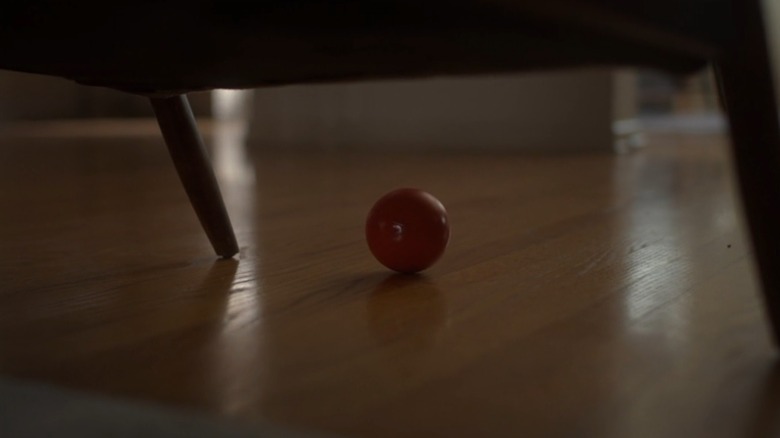American Horror Stories Game Over Ending Explained
"American Horror Story" is an anthology series known for sprinkling references and allusions to itself all throughout its disparate seasons. In the Season 1 finale of spin-off "American Horror Stories," the franchise took things a step forward and went full-on meta.
"Game Over" begins with enthusiastic couple Dylan (Adam Hagenbuch) and Connie (Noah Cyrus) arriving outside of the infamous Murder House. Except these aren't yet another pair of unsuspecting rubes about to buy the most deadly haunted house in America. They are super-fans of "American Horror Story" itself and are at the set of its first season to enjoy a specially curated overnight stay. Of course, it's not long before they encounter the many spirits contained within the house and the episode reveals its true premise.
Dylan and Connie (no doubt a reference to "Murder House" stars Dylan McDermott and Connie Britton) are actually characters in a video game. The game is being designed by Michelle (Mercedes Mason), a recently divorced mom who is desperate to find some way to relate to her increasingly distant son Rory (Nicolas Bechtel), a super-fan of "American Horror Story."
Unfortunately for Michelle, Rory isn't convinced that she understands the ethos of "Murder House" enough to do the season justice with her game adaptation. He's also concerned that she's dumping an irresponsible amount of time and money into what will likely amount to nothing but a vanity project. Determined to find a way to improve her game and win her son's respect, Michelle takes the drastic step of buying the Murder House itself to get some first-hand inspiration.
When Michelle visits her new home on Halloween night, she learns the hard way that some projects are best left unfinished.
American Horror Stories makes another return to the Murder House
Whereas the two-part "American Horror Stories" season opener "Rubber (Wo)man" further explored the mythology of the Murder House, "Game Over" digs deep into the subtext and philosophical ideas behind the setting. When Rory gets his first look at his mom's game, which features the characters Dylan and Connie being terrorized by a cavalcade of returning villains from previous seasons, he's unimpressed with her shallow take on the story.
"It's not that [the fans] want to trap more people there, they want to feel the tension of whether or not the new people are gonna be able to escape or not," Rory explains. "The thing that always trips people up in the house ... is that they don't deal with their human s— ... so they're forced to stay like that, frozen in the house forever."
Each season of "American Horror Story" has its own themes and concepts. As Rory so eloquently points out, "Murder House" isn't just about the ghastly horror of the ghouls and murderers who live there, it's about the reasons they are stuck there in the first place. In trying to cram her video game full of as many jump scares and references as possible, Michelle has demonstrated that she's missed that point. When she has her own experience at the Murder House, though, she gets a much better understanding of the psychology at play.
After purchasing the Murder House and visiting on Halloween, Michelle learns that its ghosts are all too real. She meets Dr. Ben Harmon (Dylan McDermott) and takes the opportunity to pick his brain. She's looking for a bit of insight that will help her give her game a purpose to keep the player invested in their digital journey. Unfortunately, Dr. Harmon doesn't have much to offer other than self-pity.
Michelle gets a first-hand lesson about the psychology of the Murder House
Dr. Harmon tells Michelle that life as a ghost bound to the Murder House is an unending torment. When she suggests that it might be fun, he retorts, "Fun? Is it fun when the record you're listening to skips over and over? Is it fun being on a merry-go-round for decades?"
But while Dr. Harmon feels that the repetitious nature of his life in the Murder House is hellacious, Michelle soon gets an alternate opinion on the matter. She bumps into Scarlett (Sierra McCormick) and Ruby (Kaia Gerber), the killer couple we met back in "Rubber (Wo)man." While Dr. Harmon is stuck in the house dwelling on his miserable failings as a father and husband, gleeful sadist Ruby has been making the most of her time in this between-world state.
She tells Michelle that while a few of the spirits want to be freed from this limbo, "there are others here who have no interest in growth, who embrace how f—ed up we all are ... The repetition is the point. The endless nothing filled with pain is the purpose."
Of course, shortly thereafter Michelle herself is killed and tethered to the house. Just like her son explained, she's now another soul who got trapped there because she didn't address her own shortcomings. In Michelle's case, it's the fact that she can't let go of her obsessions. Both her son and her ex-husband pleaded with her to stop working on the game but she ignored their advice and went to the Murder House to try and improve it. As Dr. Harmon puts it, "You like being hungry more than being fed."
Rory comes around to his mom's game
Although their relationship became strained, after his mom gets bound to the Murder House, Rory decides to take a drastic step to try and free her. He burns the house to the ground believing that the destruction of the property itself will free all of the souls trapped there. When the episode flashes forward several years, we learn that it worked ... mostly.
In the flashforward, Scarlett arrives to purchase a condo that was recently built on the ground where the Murder House used to stand. She hopes that Ruby's spirit will still be there and when she gets in bed at night, she finds that it is. Ruby tells her that all the other souls decided to be freed, but she opted to stay tethered to the land in hopes that Scarlett would one day return. The two have a tearful reunion before strange CGI blood splatters on the screen. The camera pans out and we're back in Michelle's living room. A twist reveals that most of the episode we just watched was actually Michelle's second attempt at crafting a Murder House video game.
The story of Michelle being undone by her obsessions, becoming the latest victim of the Murder House, and then being freed by Rory was actually her way of addressing Rory's criticism of her first attempt at adapting the series into a video game. It now not only fits the themes of the season that he laid out for her, but it also gives a clear purpose to the player.
The real meaning behind Game Over's twist ending
The episode ends on a happy note, with Rory being proud of his mom for her achievement. However, we still do get a devilish little twist. As the pair leave to get food, they wonder out loud whether the souls from Murder House who were freed would go to the great beyond, or just get released into the larger world. The very last shot — Beauregard Langdon's red ball rolling across the floor, a symbol of the spirits of the Murder House — opens up a whole other can of worms.
So, do the spirits from the "American Horror Story" universe exist in Michelle and Rory's universe? Was the story that was told in the episode actually all part of Michelle's video game, or is there a deeper "she actually is a ghost" twist at play? Given the details actually available to us, it's difficult to say for sure. But in an episode devoted to meta storytelling about "American Horror Story" and its fans, the red ball twist could have nothing to do with the characters Michelle and Rory at all.
After he beats the game, Michelle asks Rory if he wants to play through it again. He replies, "No, I think I've spent enough time in the Murder House." Considering the location was not only the central setting of the first season but also a crucial part of "American Horror Story: Apocalypse," and featured in three of the seven episodes of "American Horror Stories," maybe that line was the show's way of acknowledging that this is will be the viewer's last trip to the Murder House.
But as for the question of whether we've seen the last of the spirits that dwell within, the appearance of the red ball suggests that perhaps it's not.
